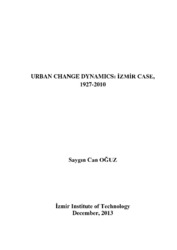Please use this identifier to cite or link to this item:
https://hdl.handle.net/11147/2971Full metadata record
| DC Field | Value | Language |
|---|---|---|
| dc.contributor.author | Oğuz, Saygın Can | - |
| dc.date.accessioned | 2014-07-22T13:48:40Z | - |
| dc.date.available | 2014-07-22T13:48:40Z | - |
| dc.date.issued | 2013 | - |
| dc.identifier.uri | http://hdl.handle.net/11147/2971 | - |
| dc.description | Thesis (Doctoral)--Izmir Institute of Technology, City and Regional Planning, Izmir, 2013 | en_US |
| dc.description | Includes bibliographical references (laves: 176-181) | en_US |
| dc.description | Text in English; Abstract: Turkish and English | en_US |
| dc.description | xv, 181 leaves | en_US |
| dc.description | Full text release delayed at author's request until 2017.01.07 | en_US |
| dc.description.abstract | This study aims to describe urban change dynamics, especially growth and decline processes of settlements, by analysing population change. The geographical unit of analysis is districts and the data used is population statistics. Before studying İzmir, an extensive research is performed for Turkey with its 957 districts. Time series analysis involve the periods 1927-2010 and 2008-2012 as a more recent period. The findings reveal that, apart from total growth picture of Turkey, the processes experienced by districts diversify. The population agglomerates to urban centres, and this process coupled by rural population loss. Heavy rural decline of districts is especially evident in Interior Anatolia and Eastern Black Sea regions. After 1990s, in relation with some national policies, the process seems accelerated. In contrast with general expectations, Eastern and South-Eastern regions do not exhibit resembling dynamics of decline, owing to fertility rates relatively higher and lowering out-migration rates. In İzmir, four main dynamics of urban change are identified. First is rapid and consistent growth of central metropolitan districts. At the same time, industrial districts proximal to city exhibited high rates of growth. Decline is a persistent issue for distant districts with economies based on agriculture. This has critical importance for İzmir, as a city having considerable agricultural resources. On the other hand, coastal districts having the characteristics of more or less holiday destinations revealed sharp growth especially after 1980s. The reasons and consequences of described dynamics are many. These need investigation by further studies with a stronger focus on local facts. | en_US |
| dc.language.iso | en | en_US |
| dc.publisher | Izmir Institute of Technology | en_US |
| dc.rights | info:eu-repo/semantics/openAccess | en_US |
| dc.subject.lcsh | Urban renewal--Turkey--Izmir | en |
| dc.subject.lcsh | Population--Turkey--Izmir | en |
| dc.subject.lcsh | City planning--Turkey--Izmir | en |
| dc.title | Urban change dynamics: Izmir case, 1927-2010 | en_US |
| dc.type | Doctoral Thesis | en_US |
| dc.institutionauthor | Oğuz, Saygın Can | - |
| dc.department | Thesis (Doctoral)--İzmir Institute of Technology, City and Regional Planning | en_US |
| dc.relation.publicationcategory | Tez | en_US |
| dc.identifier.wosquality | N/A | - |
| dc.identifier.scopusquality | N/A | - |
| item.openairecristype | http://purl.org/coar/resource_type/c_18cf | - |
| item.languageiso639-1 | en | - |
| item.openairetype | Doctoral Thesis | - |
| item.grantfulltext | open | - |
| item.fulltext | With Fulltext | - |
| item.cerifentitytype | Publications | - |
| Appears in Collections: | Phd Degree / Doktora | |
Files in This Item:
| File | Description | Size | Format | |
|---|---|---|---|---|
| 10013164.pdf | DoctoralThesis | 7.72 MB | Adobe PDF |  View/Open |
CORE Recommender
Page view(s)
318
checked on Mar 31, 2025
Download(s)
510
checked on Mar 31, 2025
Google ScholarTM
Check
Items in GCRIS Repository are protected by copyright, with all rights reserved, unless otherwise indicated.